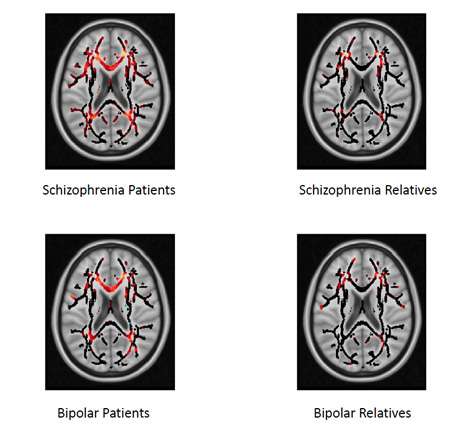Common biology shared in schizophrenia and bipolar disorder

(Medical Xpress)—Patients suffering from schizophrenia and bipolar disorder share similar cognitive and brain abnormalities, three new multi-site studies show. The findings, published in the November issue of the American Journal of Psychiatry, add to growing literature that the two disorders share a common biology.
"We have known for a long time that the clinical symptoms are shared substantially between the two conditions, but when you look at the biology, these illnesses also blur into each other," said Godfrey Pearlson, professor of psychiatry and neurobiology and a co-author of the studies. "It is clear that they are not two nicely separated packages, but there is a substantial crossover between the two."
The diagnoses of bipolar disorder and schizophrenia have been used for almost a century to differentiate between symptoms, outcomes, and more recently, response to medications. However, a growing number of researchers are beginning to question whether they are useful tools for the classification, understanding, and treatment of major mental illness.
While genome-wide analysis of patients' DNA has not revealed clear-cut genetic culprits, researchers have known for years that schizophrenia and bipolar patients share similar abnormalities in such measures as eye movement and response to electroencephalogram tests. Similar abnormalities are also often seen in their non-ill close relatives.
Researchers at Yale and the Institute of Living in Hartford—as well as four other sites in Massachusetts, Illinois, Texas and Maryland— are studying 20 potential biological disease indicators in 3,000 individuals. The subjects include those with schizophrenia and psychotic bipolar disorder, as well as their close relatives and unrelated healthy controls. The study is known as BSNIP (Bipolar-Schizophrenia Network on Intermediate Phenotypes).
The new studies also show similar deficits in the brain among grey matter (neurons) and white matter (neuronal projections and connective cells) among schizophrenia and bipolar patients. Also, the two conditions share similar forms of cognitive problems. There are no clear-cut biological distinctions separating the conditions. Intriguingly, similar brain abnormalities and cognitive deficits are shared to a lesser degree by relatives of the patients and likely represent markers of disease susceptibility.
These findings may lead researchers to common genetic causes of these deficits. Pearlson also noted that the National Institute of Mental Health recently proposed a reclassification of mental illnesses based on biological measures.














